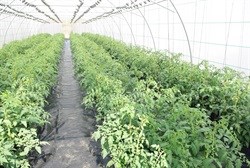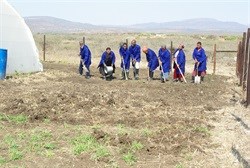Members of a small co-operative in the Matheni traditional authority area in northern Zululand have started to reap the rewards of patience and hard work.
The two-tunnel hydroponic project initiated over four years ago by Zululand Anthracite Colliery's sustainable development section started out with 60 potential beneficiaries, dwindling to a dedicated group of eight. The project was put on hold in 2011, but was recently resurrected and implemented.
To become commercial farmers

One of the tunnels where tomato plants are already in flower.
"We are very excited and happy that this project is finally off the ground," said ZAC Sustainable Development Manager, Zodwa Ntuli. "Through this project, we have now put eight people on the first rung of their ladders of success. With help from marketing professionals and their combined determination and commitment, they can only succeed and become commercial farmers."
Construction of the specialised hydroponic tunnels was completed in June this year and soon afterwards rows of tomato seedlings began sprouting to be nurtured and cared for by the project beneficiaries.
Chairman of the group, Johannes Makhathina, had the smile of a proud father as he explained how they were already planning to expand their project with more tunnels to accommodate a variety of peppers.
Now retired, after working in Johannesburg for Anglo American for many years, Makhathini is excited with the opportunity ZAC has given him and his new business partners to help them earn a living.
Earning a living selling vegetables

Tilling and preparing the soil to ensure the new vegetable crops have the best start, are group members: Johannes MakhathinI; Lungile Nxumalo; Celimpilo Dlomo; Phendula Cebekhulu; Thobile Zulu; Bonisiwe Nxumalo; Elizabeth Zulu; and Nomcebo Sithole.
The group has not stopped at caring and tending to the hundreds of tomato plants in the tunnels. It's expanded the crops to include spinach, onions and cabbages, and has started growing green pepper seedlings.
All eight members were previously unemployed and live in the community surrounding the fenced-off vegetable garden and hydroponic tunnel project area.
"We were growing our own vegetables at home for our own use as we were not employed and had no income," said group member Elizabeth Zulu. "But now we can earn money from growing bigger crops and selling our vegetables," she added.
Water is drawn from the Black Umfolozi River via ZAC's nearby Ngwabe Shaft, and is pumped to the project. Besides regular fertilizer, cattle manure is collected from the area where cattle graze freely, and is carefully matured before being used to enrich the soil for better vegetable results.
The vegetables will be ready to be sent to markets around the end of September/beginning of October.









































